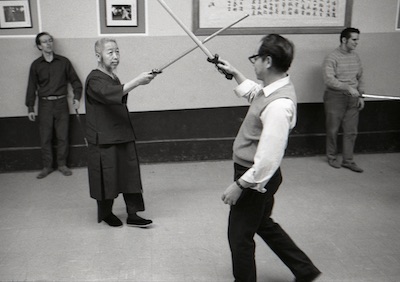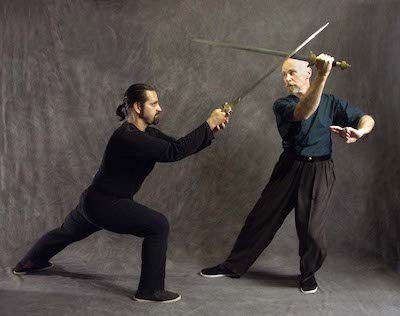SWORD MOVEMENT
Two issues are involved here. One is how the sword moves and the other is where the movement originates.
The sword is long and narrow like a stick; it moves with little effort along its length as it is lined up like an arrow when we thrust, much as in western fencing. In order to affect a slice or cut western fencing manipulates the point by using arm and wrist strength. This works quite well with the extremely light sport fencing instruments but not so well with the heavier duelling swords that preceded them.

Tai Chi principles lead us to moving the point by moving our grip / hand in the opposite direction, leaving the centre of the ‘stick’ relatively still like a lever, with little wrist strength required. The Tai Chi sword is heavier at the handle than other swords, with its centre 2 to 6 inches in front of the guard. This centre is where its stillness lies and that enables us to move a somewhat heavy sword lightly and quickly. Our arms do not move much from our shoulders but are directed from our centre.
When cutting the movement of the blade requires special attention. In grand cutting movements such as “Block and Sweep” the sword must start out by being moved along its length, with the pommel aimed in the direction of the intended cut. As we turn from our centre the centrifugal force will help the blade speed to increase and the point to extend. The forearm and the sword begin at about a 90-degree angle to each other, and by the time the blade meets its target, the forearm and the sword are almost lined up.
With moderate cuts such as “Tassels in the Wind” the forearm and the sword begin at about a 45-degree angle and with surgical cuts such as “Searching for Snake in Grass” the forearm and sword stay more or less aligned.
While executing any cut the blade must travel from edge to edge. Any deviation will cause the blade to fly or dive, or to some degree, deviate from its intended course.
On the other hand, while receiving the O’s blade defensively, that is, while sticking, adhering, listening and neutralizing, the blade is kept at whatever angle is appropriate for those skills. Then, as we cut or thrust, we change the blade angle to cutting mode.
Since the origin of these movements is from our centre (Dan Tien), the sword hand and blade stay mostly between ourselves and the O, whilst moving from, and with our centre. This is more crucial with the sword than with the empty hand, as most martial artists can take a strong punch or palm strike to the body, but no one can receive even an inch of sharp steel without being seriously inconvenienced.
Author and Images: Ken van Sickle
German version on our sister site!
- ON BEING A MASTER – Tai Chi Sword 53
- STRANGERS – Tai Chi Sword 52
- PADDED SWORDS – Tai Chi Sword 51
- SAFETY – Tai Chi Sword 50
- PARALLELS – Tai Chi Sword 49
- Swordsmanship – SEVEN QUOTES – Tai Chi Sword 48
- TI FENG & FA JING – Tai Chi Sword 47
- SUPPOSITIONS – Tai Chi Sword 46
- LAO TZU (Laozi) QUOTES – Tai Chi Sword 45
- ETIQUETTE – Tai Chi Sword 44
- FENCING PROCESS – Tai Chi Sword 43
- STRATEGIES – Tai Chi Sword 42
- TASSELS IN THE WIND – Tai Chi Sword 41
- SHOOT FLYING GOOSE – Tai Chi Sword 40
- RHINOCEROS GAZES AT MOON – Tai Chi Sword 39
- THE MASTER SITS BACK – Tai Chi Sword 38
- FIVE APPLICATIONS – 1. BLOCK AND SWEEP – Tai Chi Sword 37
- RULES OF ENGAGEMENT – Tai Chi Sword 36
- CONSIDER – Tai Chi Sword 35
- INVITATIONS – Tai Chi Sword 34
- THE TASSEL – Tai Chi Sword 33
- THE SWORD FINGERS – Tai Chi Sword 32
- Cheng Man Ching Photographs
- THE JOINTS – Tai Chi Sword 31
- THE GRIP – Tai Chi Sword 30
- SWORD MOVEMENT – Tai Chi Sword 29
- ON ALIGNMENT – Tai Chi Sword 28
- CONCERNING THE CENTRE – Tai Chi Sword 27
- EQUATIONS – Tai Chi Sword 26
- HSIN AND CHI – Tai Chi Sword 25
- On studying – NINE QUOTES – Tai Chi Sword 24
- THE SWORD MAIDENS – Tai Chi Sword 23
- THE SWORD AND CALLIGRAPHY – Tai Chi Sword 22
- Returning – MORE THOUGHTS – Tai Chi Sword 21
- Levels of TAI CHI SWORD – Tai Chi Sword 20
- FENCING – Tai Chi Sword 19
- Transcendence – Tai Chi Sword 18
- TURNING TRICKS – Tai Chi Sword 17
- Names of CHENG MAN CH’ING’S TAI CHI SWORD – Tai Chi Sword 16
- FORCE – Tai Chi Sword 15
- DIFFERENCES – Tai Chi Sword 14
- BEGINNERS’ MISTAKES – Tai Chi Sword 13
- MIND SETS – Tai Chi Sword 12
- SENSITIVITY – Tai Chi Sword 11
- HARMONY – Tai Chi Sword 10
- TIME AND HUMOUR – Tai Chi Sword 9
- WHY AND HOW – Tai Chi Sword 8
- SWORD DIMENSIONS – Tai Chi Sword 7
- A ROYALTY OF ARMS – Tai Chi Sword 6
- KENNETH VAN SICKLE – Tai Chi Sword 4
- CHENG MAN CH’ING – Tai Chi Sword 5
- PREFACE – Tai Chi Sword 3
- Introductory Thoughts – Tai Chi Sword 2
- EDITOR’S PREFACE -Tai Chi Sword 1
- Tai Chi Sword by Kenneth van Sickle




